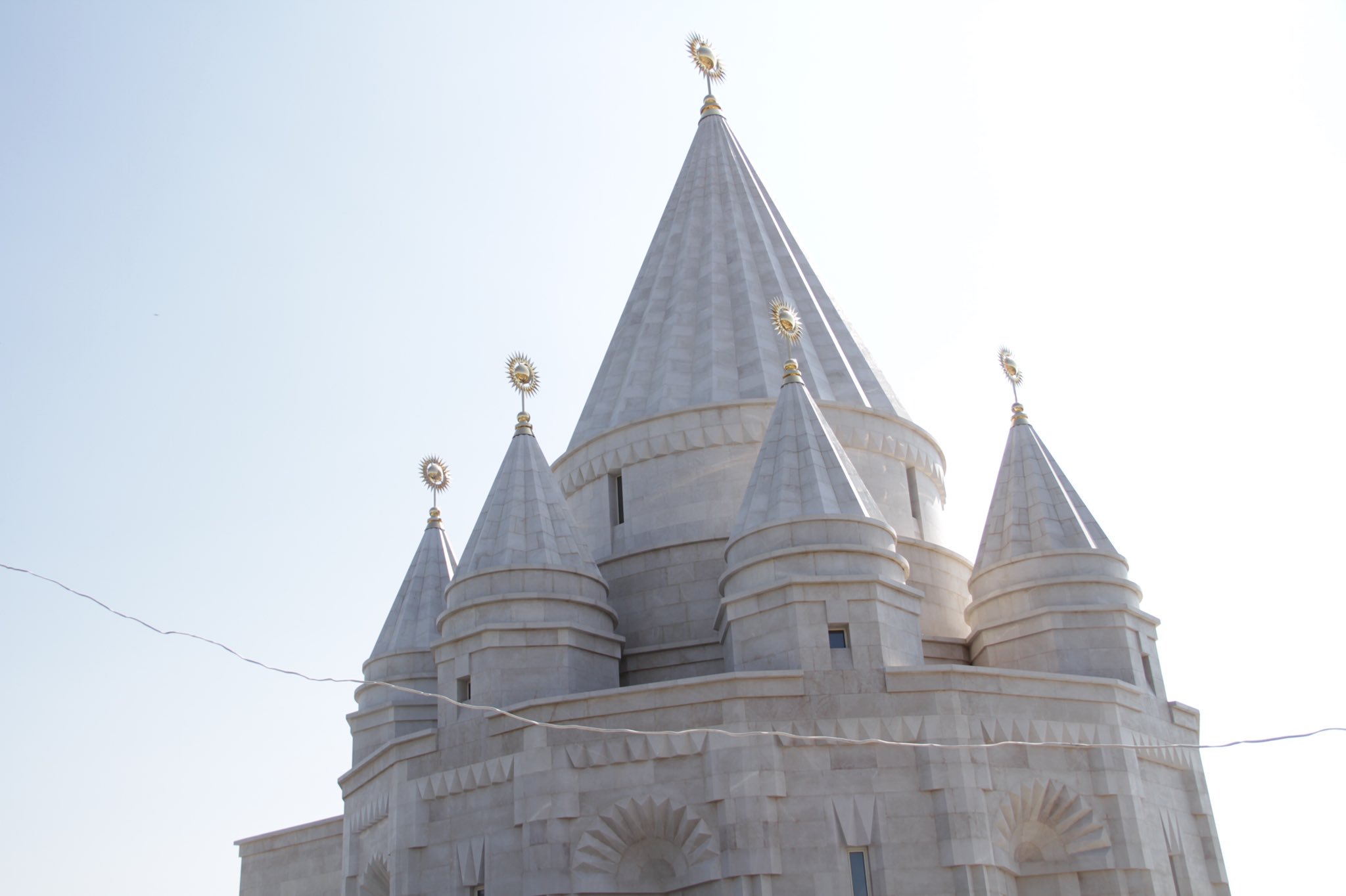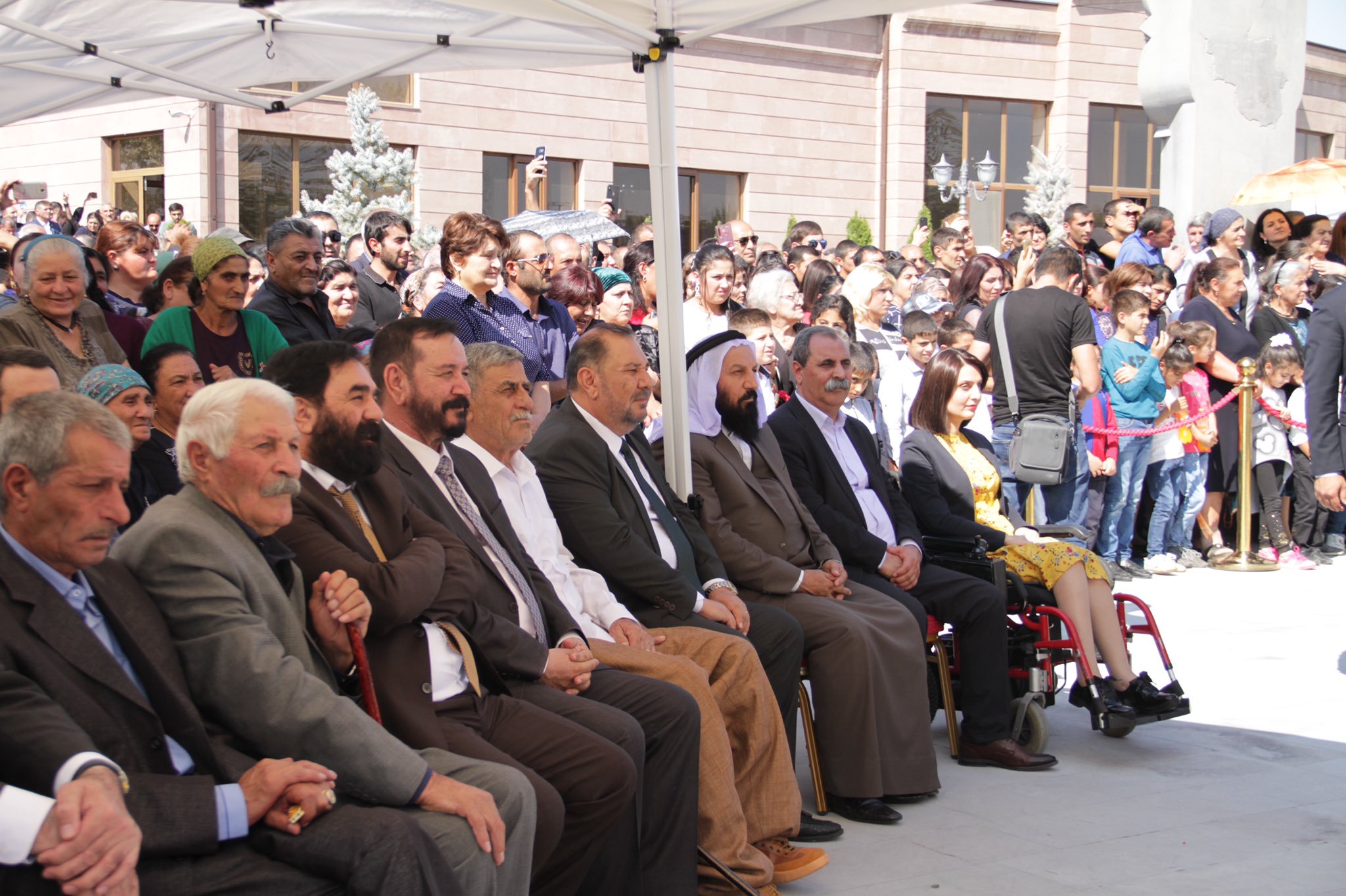
While the small community of Aknalich, just outside of Medzamor, may look like any average-sized town in Armenia, the newly-constructed conical structure that dominates its skyline exposes a certain distinctive quality. Indeed, the large dome does not cover an Armenian Apostolic Church, nor are its 3000 inhabitants ethnic Armenians. They are Yezidis, members of Armenia’s largest minority community.
The structure in question is the newly completed “Malek Taus and the Seven Angels” temple, which formally opened during a ceremony attended by high-ranking officials on September 29. While it is the second Yezidi temple to be erected in Aknalich, it is by far the largest of its kind anywhere in the world.
The seven-domed temple, capped by golden sun-shaped ornaments, was made possible through funding from an Armenian-born Yezidi businessman, Mirza Sloian, who made his money in Moscow. Astute observers may note some superficial design commonalities with some contemporary Armenian churches, including the newly-built Moscow Cathedral, the massive St. Hovhanness Church in Artashat, and its similarly-named counterpart in the town of Abovian. This, of course, is no coincidence, as all these houses of worship bear the stroke of the same architect’s pen. For architect Artak Ghulyan (a favorite of Catholicos Karekin II, as well as several notorious oligarchs), this is a first non-Christian religious design.
Aesthetic considerations aside, for many Yezidis, this new temple offers symbolic as well as concrete opportunities. Sashik Sultanyan, a Yezidi activist who heads the Yezidi Center for Human Rights explains that despite empathy from the Armenian government, this ethnic minority continues to face challenges due to a lack of institutional support for preserving and transmitting their unique culture and language. The most pressing issue, he continues, is a lack of properly trained teachers or textbooks. Sultanyan views this temple as a focal point upon which his community could congregate.
Melek Taus, who according to tradition takes the form of a peacock, is the central deity in Yazidi religion—the leader of the seven angels entrusted by God to care for the world. The symbolism of the seven angels also alludes to the hope that Yezidis from the seven continents will be united by this temple.
An inaccurate translation of Melek Taus into Arabic as “Shaytan” (or Satan) has led to centuries-worth of cruel discrimination against the Yazidi community across the Middle East. Religious bigotry built on accusations of Satan-worship would ultimately culminate in the majority of the Yezidi community suffering the same fate as the Armenians during the Genocide of 1915. Some of the atrocities committed against them were at the hands of their ethnic kin, the Kurds.
Those who survived those massacres joined the caravans of fleeing Armenians until they found refuge at the foot of Mount Arakads. Today over 35 thousand of their descendants continue to live across villages scattered around the base of modern Armenia’s highest mountain, where they engage in agriculture and sheep herding. Most have even adopted the Armenian-sounding “yan” suffix in their surnames.
“Yezidis have participated in the building of the Armenian State since the First Republic,” says Sashik. “We are an inseparable part of Armenia.” Indeed, many of the young men who took an active part in the defense of Artsakh during the Four Day War in April 2016 came from these same impoverished villages perched on the flanks of Mount Arakads. Notable, footage of the severed head of Private Karam Sloyan clutched by Azeri soldiers sparked outrage across Armenia. The young Yezidi had stayed behind to hold his post during the first the early hours of the Azeri onslaught. His headless body would later be entered at a cemetery outside his native Ashtarak in Aragatsotn Marz. Another young Yezidi soldier, Sidar Aloyan also gave his life for Artsakh.
Despite their contributions, most Yezidis remain detached from Armenian society. Some also face condescending attitudes from Armenians or find themselves the butt of racist jokes. The key to reversing the Yezidi’s prospects, according to Sultanyan is to help integrate their community into the socio-economic life of Armenia.
Despite a history of empty promises from Armenian authorities, there are signs that things may be changing. Armenia’s Constitution was amended in 2015 to, in part, allocate reserved parliamentary seats to Armenia’s ethnic minorities: the Yezidis, Greeks, Assyrians, Russians and even Kurds, whose ancestors also escaped Genocide. Rustam Makhmudyan was the first ethnic Yezidi to hold the seat since the amendment passed. It is currently held by Rustam Bakoyan, an MP from the governing My Step faction.
In 2014, as many Armenian Yezidis watched in horror as their kin suffered extermination and slavery at the hands of ISIS in one of the ongoing Syrian Civil War’s most tragic episodes, the Armenian Parliament unanimously passed a resolution condemning these massacres as ‘Genocide.’ The country also welcomed hundreds of ethnic Yezidi refugees along with those Armenians fleeing violence in Syria. MP Bakoyan even spearheaded an outreach effort on the part of Armenia to Yazidi community leaders in Iraq.
Still, the dominating presence of the Temple of the Seven Angels on the skyline of Aknalich stands as a reminder of the resilience of Armenia’s largest ethnic minority and a commitment to, in Sultanyan’s words, “continue to forge our destiny in tandem with Armenia’s.”



Be the first to comment